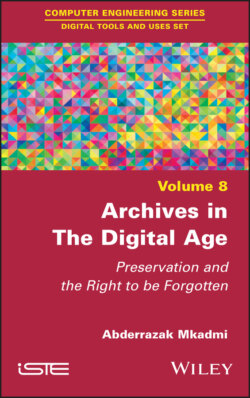Читать книгу Archives in the Digital Age - Abderrazak Mkadmi - Страница 35
1.6. Conclusion
ОглавлениеWe have tried, in this introductory chapter, to give an idea of the terminology related to the field of archiving, while presenting some elements of definitions of archives, the challenges and objectives of their management, and the traditional tools on which any archiving policy is based. We also treated the transition of these archives into digital forms through the technology of electronic document management and records management. We have shown, on the one hand, the difference between these two technologies through the object of their management, namely, all types of documents for electronic document management and documents validated for records management, and, on the other hand, their link through EDRMS technology, as well as the evolution toward content management systems (ECM). We will try in Chapter 2 to develop this transition to digital further through the methods and strategies of digital archiving, while presenting the normative landscape governing this area.
1 1 The French Heritage Code (art. L. 211-4); Tunisian Law No. 88-95 of August 2, 1988 on archives (art. 1).
2 2 CCITT (Consultative Committee for International Telephony and Telegraphy): this is a standardization body that has developed a series of communication protocols for the facsimile transmission of black and white images over telephone lines and data networks. These protocols are formally referred to as CCITT T.4 and T.6 standards, but are more commonly referred to as CCITT Group 3 and Group 4 compression, respectively.
3 3 ITU-T T6 is a recommendation of the International Telecommunication Union that defines the fax coding schemes and fax coding control functions for Group 4 facsimile machines.
4 4 JBIG (Joint Bi-level Image Expert Group) is a group of experts that develops standards for bilevel image coding. Officially, JBIG is the ISO/IEC JTC1 SC29 working group, which is also responsible for the JPEG standard for a suite of compression algorithms used to produce image files supported by web browsers and typically used for complex images such as photographs.
5 5 JPEG (Joint Photographic Experts Group) is a standard that defines the recording format and decoding algorithm for a compressed digital representation of a still image.
6 6 Metadata are the set of identification and description elements of electronic resources. These elements are increasingly modelled and standardized to unify and generalize their use.
7 7 This is a digital disk format patented and marketed since 2006 by Sony (Japanese industrialist) allowing videograms to be stored and remastered in high definition.
8 8 A workflow can be defined simply as an industrial, administrative or other process through which a job is passed from start to finish.
9 9 This second part has not been revised and has already been annulled (according to its status on the ISO website).
10 10 The DLM Forum is a European community of members of public archives and parties interested in the management of archives, documents and information throughout the European Union.
11 11 We will return to these processes and elements of a record management system according to MoReq in section 2.4 of Chapter 2.
12 12 We will detail these new methods in Chapter 3, which is dedicated to archives in the age of digital humanities.
